In Vitro and in Vivo Antioxidant Properties of the Plant-Based Supplement Greens+
Abstract
:1. Introduction
2. Experimental Methods
2.1. Materials
2.2. In Vitro Study
2.2.1. ABTS+ • Decoloration Assay
2.2.2. Liposomal Lipid Peroxidation
2.2.3. Polyphenol Analysis in Green+ Herbal Preparation
2.2.4. HPLC Analysis
2.3. In Vivo Study
2.3.1. Evaluation of Plasma Polyphenols and Antioxidant Properties of Greens+ Herbal Preparation
2.3.1.1. Subjects
2.3.1.2. Study Design
2.3.2. Polyphenol Analysis in Plasma after Greens+ Supplementation
2.3.3. Oxidative Biomarker Analyses
2.3.3.1. Total Antioxidant Capacity in Vivo
2.3.3.2. Protein Oxidation
2.3.3.3. Lipid Peroxidation
2.3.3.4. LDL Oxidation
2.3.3.5. Determination of Glutathione Peroxidase in Erythrocytes
2.4. Statistical Analysis
3. Results and Discussion
3.1. In Vitro Study
3.1.1. Total Antioxidant Properties of Greens+™ Herbal Preparation
3.1.2. Identification and Quantification of Polyphenols in Greens+
3.2. In Vivo Study
3.2.1. Effect of Ingesting Greens+ on Body Weight, BMI and Blood Pressure
3.2.2. Effect of Ingesting Greens+ on Total Antioxidant Capacity
3.2.3. Effect of Ingesting Greens+ on Lipid Oxidation
3.2.4. Effect of Ingesting Greens+ on Protein Oxidation
3.2.5. Effect of Ingesting Greens+ on Erythrocyte Glutathione Peroxidase
4. Conclusions
Acknowledgments
References
- Simonian, NA; Coyle, JT. Oxidative stress in neurodegenerative diseases. Annu. Rev. Pharmacol. Toxicol 1996, 36, 83–106. [Google Scholar]
- Dhalla, NS; Temsah, RM; Netticadan, T. Role of oxidative stress in cardiovascular diseases. J. Hypertens 2000, 18, 655–673. [Google Scholar]
- Van’t Veer, P; Jansen, MC; Klerk, M; Kok, FJ. Fruits and vegetables in the prevention of cancer and cardiovascular disease. Public Health Nutr 2000, 3, 103–107. [Google Scholar]
- Bokov, A; Chaudhuri, A; Richardson, A. The role of oxidative damage and stress in aging. Mech. Ageing Dev 2004, 125, 811–826. [Google Scholar]
- Madamanchi, NR; Vendrov, A; Runge, MS. Oxidative stress and vascular disease. Arterioscler. Thromb. Vasc. Biol 2005, 25, 29–38. [Google Scholar]
- Bravo, L. Polyphenol: Chemistry, dietary sources, metabolism, and nutritional significance. Nutr. Rev 1998, 56, 317–333. [Google Scholar]
- Heim, KE; Tagliaferro, AR; Bobilya, DJ. Flavonoid antioxidants: Chemistry, metabolism and structure-activity relationships. J. Nutr. Biochem 2002, 13, 572–584. [Google Scholar]
- Pier-Giorgio, P. Flavonoids as antioxidants. J. Nat. Prod 2000, 63, 1035–1042. [Google Scholar]
- Rice-Evans, C; Miller, N; Paganga, G. Antioxidant properties of phenoilc compounds. Trends Plant Sci 1997, 2, 152–159. [Google Scholar]
- Sealbert, A; Johnson, J; Saltmarsh, M. Polyphenols: Antioxidants and beyond. Am. J. Clin. Nutr 2005, 81, 2155–2175. [Google Scholar]
- Ross, JA; Kasum, CM. Dietary flavonoids: Bioavailability, metabolic effects, and safety. Ann. Rev. Nutr 2002, 22, 19–34. [Google Scholar]
- Rice-Evans, CA; Miller, NJ; Paganga, G. Structure-antioxidant activity relationships of flavonoids and phenolic acids. Free Radic. Biol. Med 1996, 20, 933–956. [Google Scholar]
- Berardi, J; Logan, A; Rao, AV. Plant based dietary supplement increases urinary pH. J. Int. Soc. Sports Nutr 2008, 5, 20. [Google Scholar]
- Bloom, H. Effect of greens+: A randomized, controlled trial. Can. J. Diet Pract. Res 2004, 65, 66–71. [Google Scholar]
- Rao, LG; Balachandran, B; Rao, AV. Polyphenol extract of greens+TM nutritional supplement stimulates bone formation in cultures of human osteoblast-like SaOS-2 cells. J. Herb. Pharmacother 2008, 5, 264–282. [Google Scholar]
- Re, R; Pellegrini, N; Proteggente, A; Pannala, A; Yang, M; Rice-Evans, C. Antioxidant activity: Applying an improved ABTS radical cation decolorization assay. Free Radic. Biol. Med 1999, 26, 1231–1237. [Google Scholar]
- Balachandran, B; Rao, AV. Time dependent uptake and antiperoxidative potential of lycopene in multilamellar liposomes. Food Res. Int 2003, 36, 611–616. [Google Scholar]
- Draper, HH; Squires, EJ; Mahmood, H; Wu, J; Agarwal, S; Hadley, MA. Comparative evaluation of thiobarbituric acid methods for the determination of malondialdehyde in biological materials. Free Radic. Biol. Med 1993, 15, 353–363. [Google Scholar]
- Hollman, PCH; van Trijp, JMP; Buysman, MNCP. Fluorescence detection of flavonols in HPLC by postcolumn chelation with aluminum. Anal. Chem 1996, 68, 3511–3515. [Google Scholar]
- Hu, ML. Measurement of protein thiol groups and glutathione in plasma. Meth. Enzymol 1994, 233, 380–385. [Google Scholar]
- Wieland, H; Seidel, D. A Simple specific method for precipitation of low density lipoproteins. J. Lipid Res 1983, 24, 904–909. [Google Scholar]
- Allain, CA; Poon, LS; Chan, CSG; Richmond, W; Fu, PC. Enzymatic determination of total serum cholesterol. Clin. Chem 1974, 20, 470–474. [Google Scholar]
- Pleban, PA; Munyani, A; Beachum, J. Determination of selenium concentration and glutathione peroxidase activity in plasma and erythrocytes. Clin. Chem 1982, 28, 311–315. [Google Scholar]
- Terao, J. Dietary flavonoids as antioxidants in vivo: Conjugated metabolites of (−)-epicatechin and quercetin participate in antioxidative defense in blood plasma. J. Med. Invest 1999, 46, 159–168. [Google Scholar]
- Cao, G; Russell, RM; Lischner, N; Prior, RL. Serum antioxidant capacity is increased by consumption of strawberries, spinach, red wine or vitamin C in elderly women. J. Nutr 1998, 128, 2383–2390. [Google Scholar]
- Frei, B. Efficacy of dietary antioxidants to prevent oxidative damage and inhibit chronic disease. J. Nutr 2004, 134, 3196S–3198S. [Google Scholar]
- Descamps-Latscha, B; Witko-Sarsat, V; London, GM; Nguyen-Khoa, T; Nguyen, AT; Gausson, V; Mothu, N; Jungers, P. Oxidation protein products as risk factors for atherosclerotic cardiovascular events in nondiabetic predialysis patients. Am. J. Kidney Dis 2005, 45, 39–47. [Google Scholar]
- Hall, NC; Gillan, AH. Effects of antirheumatic drugs on protein sulphydral reactivity of human serum. J. Pharm. Pharmacol 1979, 31, 676–680. [Google Scholar]
- Kadota, K; Yui, Y; Hattori, R; Murohara, Y; Kawai, C. Decreased sulfhydryl groups of serum albumin in coronary artery disease. Jpn. Circ. J 1991, 55, 937–941. [Google Scholar]
- Hider, RC; Liu, ZD; Khodr, HH. Metal chelation of polyphenols. Meth. Enzymol 2001, 335, 190–203. [Google Scholar]
- Diniz, A; Escuder-Gilabert, L; Lopes, NP; Villanueva-Camanas, RM; Sagrado, S; Medina-Hernandez, MJ. Characterization of interactions between polyphenolic compounds and human serum proteins by capillary electrophoresis. Anal. Bioanal. Chem 2008, 391, 625–632. [Google Scholar]
- Rao, AV; Shen, H; Agarwal, A; Yatcilla, MT; Agarwal, S. Bioabsorption and in vivo antioxidant properties of grape extract biovin®: A human intervention study. J. Med. Food 2000, 3, 15–22. [Google Scholar]
- Van het Hof, KH; de Boer, HSM; Wiseman, SA; Lien, N; Wetstrate, JA; Tijburg, LBM. Consumption of green or black tea does not increase resistance of low-density lipoprotein to oxidation in humans. Am. J. Clin. Nutr 1997, 66, 1125–1132. [Google Scholar]
- McAnlis, GT; McEneny, J; Pearce, J; Young, IS. Black tea consumption does not protect low density lipoprotein from oxidative modification. Eur. J. Clin. Nutr 1998, 52, 202–206. [Google Scholar]
- Princen, HMG; van Duyvenvoorde, W; Buytenhek, R; Blonk, C; Tijburg, LBM; Langius, JAE; Meinders, AE; Pijl, H. No effect of consumption of green and black tea on plasma lipid and antioxidant levels and on LDL oxidation in smokers. Arterioscler. Thromb. Vasc. Biol 1998, 18, 833–841. [Google Scholar]
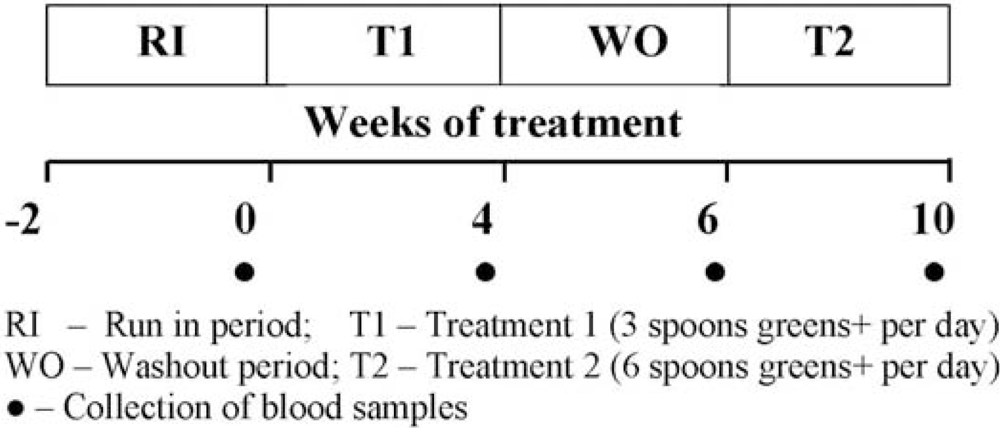
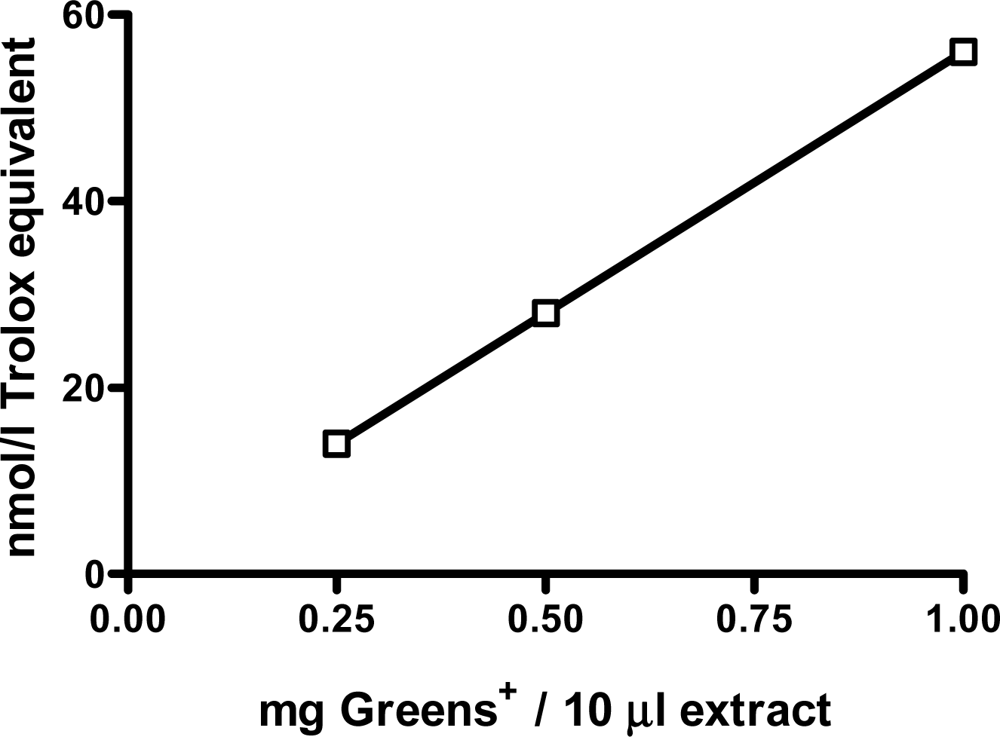
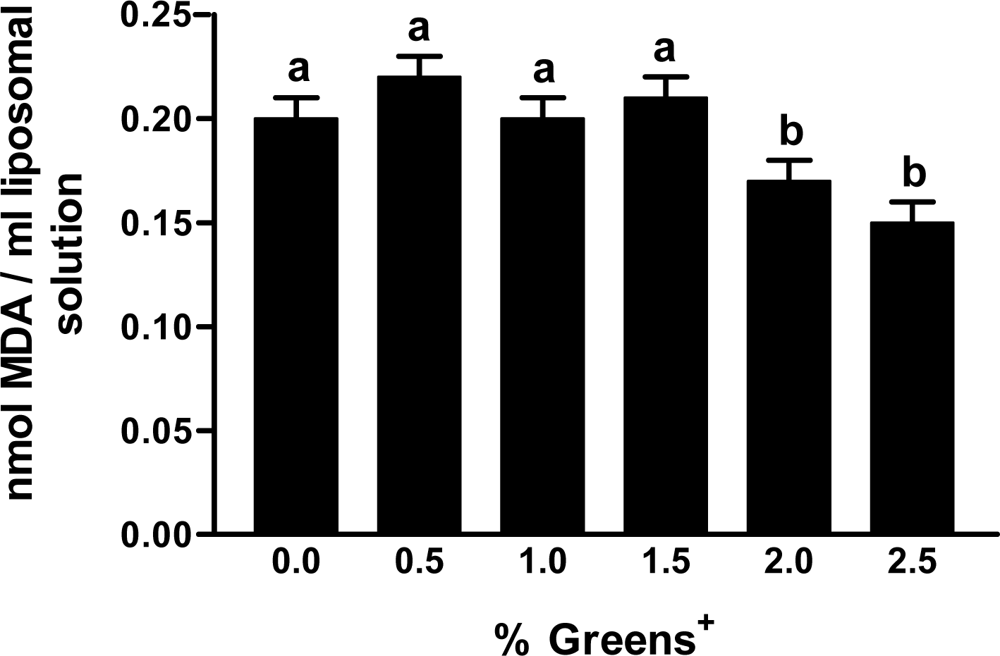
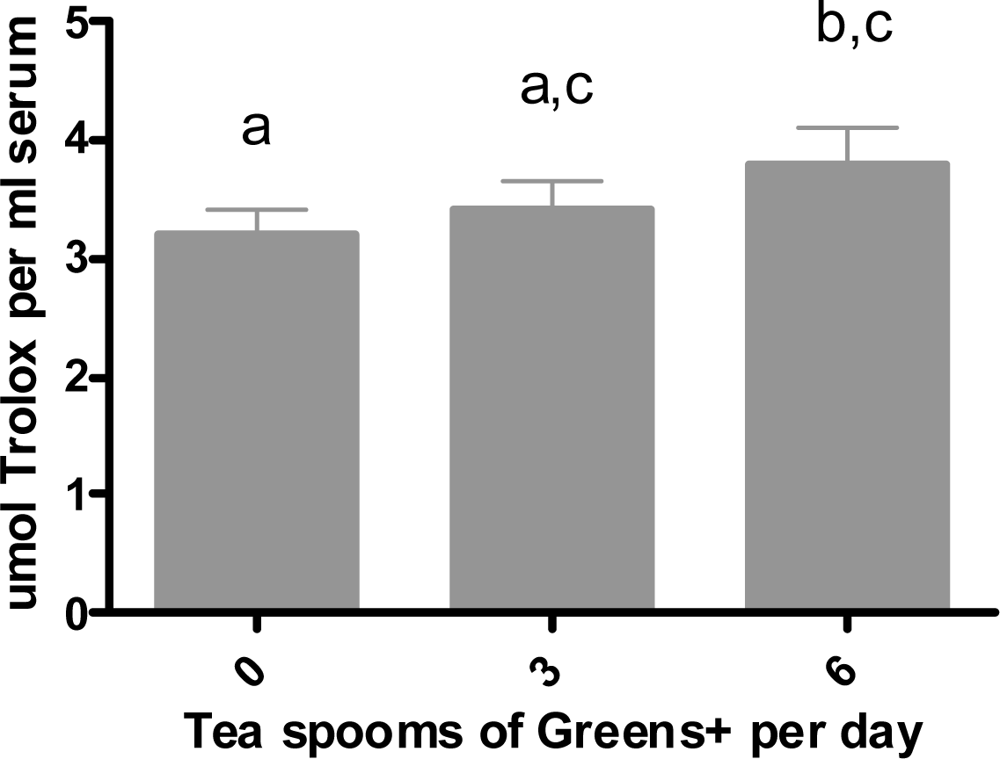
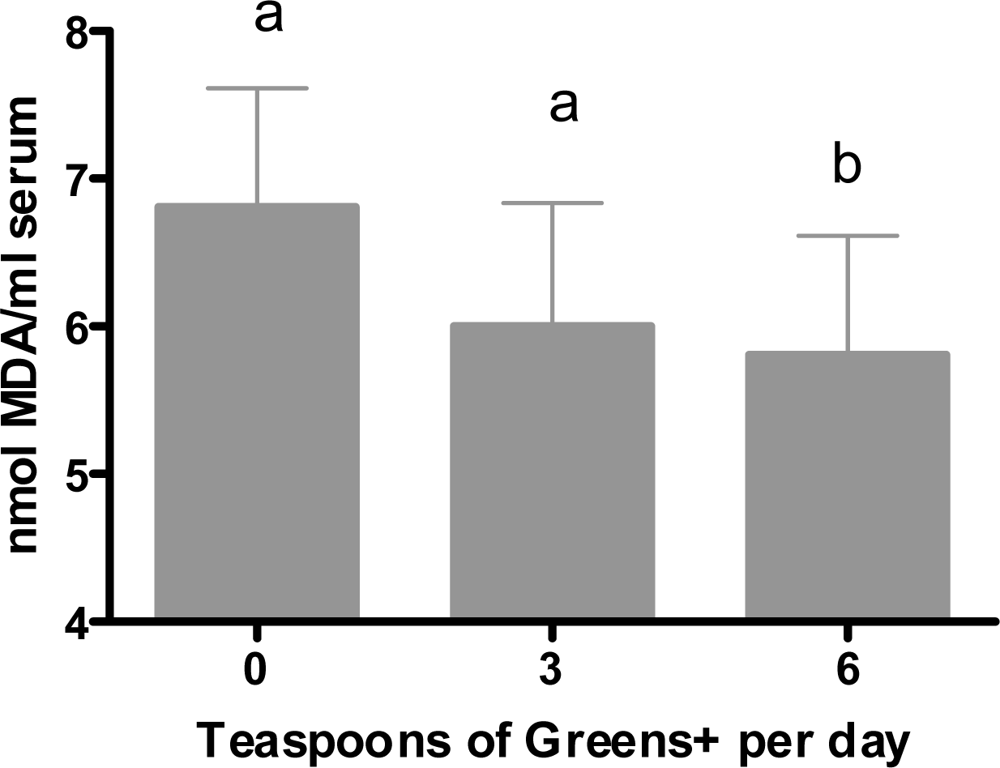
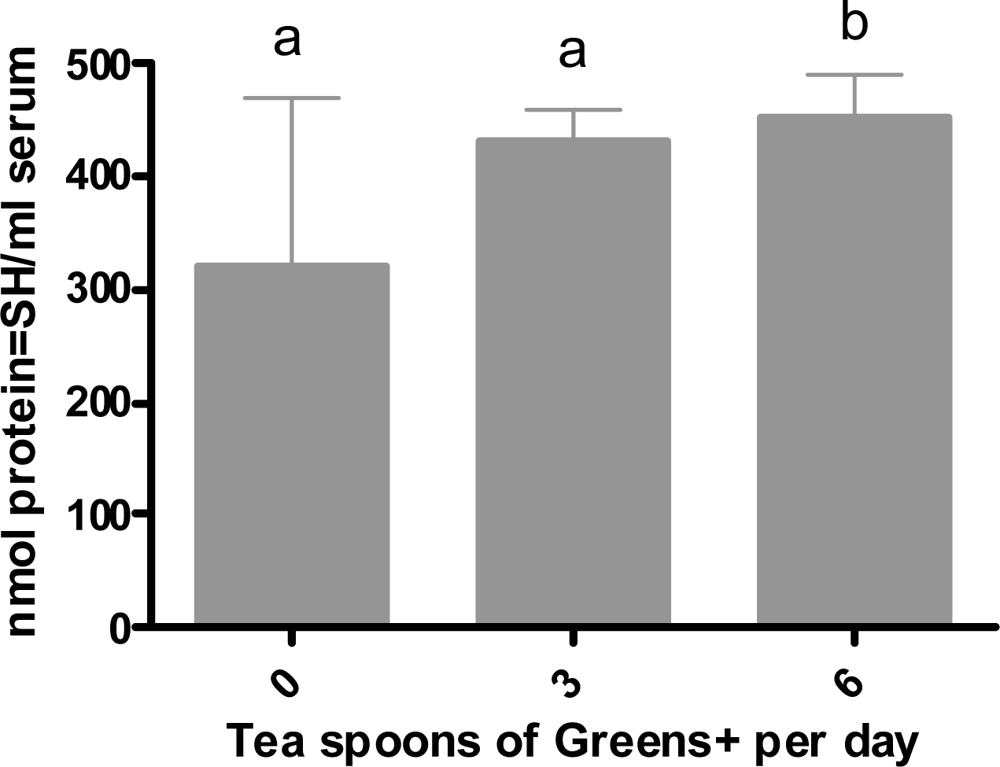
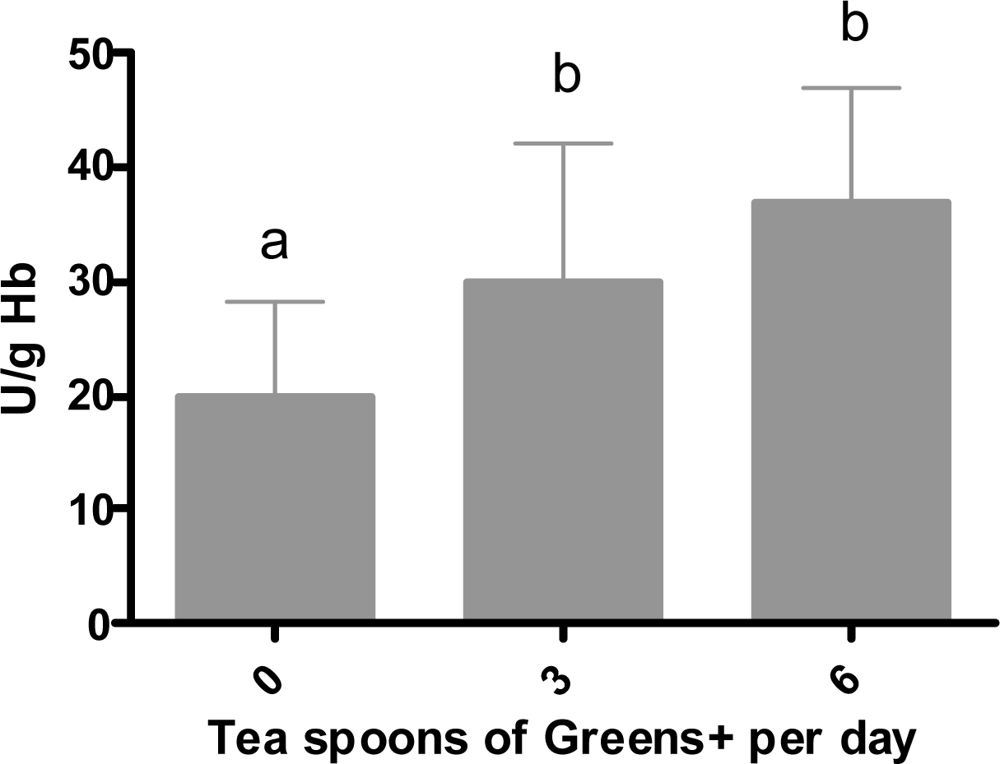
| Ingredients per 8.5 g serving of supplement | ||
|---|---|---|
| Phosphatide complex (26% phosphatidyl choline from 97% oil-free lecithin) | 2,171 | mg |
| Organic barley, alfalfa and wheat grass, and red beet powders | 1,543 | mg |
| Spirulina | 1,450 | mg |
| Apple fiber powder | 1,033 | mg |
| Japanese chlorella (cracked cell) | 383 | mg |
| Organic soy sprout powder | 383 | mg |
| Organic whole brown rice powder | 383 | mg |
| Stevia leaf powder | 225 | mg |
| Eight non-dairy bacterial cultures containing Lactobacilli and bifidobacteria (2.5 billion per serving) in a special base of fructo-oligosaccharides (FOS) | 200 | mg |
| Royal jelly (5% 10-HDA) | 150 | mg |
| Bee pollen powder | 150 | mg |
| Licorice root extract standardized to 10% glycyrrhizin (5:1 = 580 mg) | 116 | mg |
| Acerola berry extract standardized to 18% Vitamin C | 115 | mg |
| Siberian ginseng extract standardized to 0.8% eleutherosides (28:1 = 1,680 mg) | 60 | mg |
| Milk thistle extract standardized to 80% silymarin (15:1 = 900 mg) | 60 | mg |
| Organic Atlantic dulse powder | 33 | mg |
| Ginkgo biloba extract standardized to 24% ginkgo flavonglycosides and 6% terpene lactones (50:1 = 1,000 mg) | 20 | mg |
| Japanese green tea extract standardized to 90% polyphenols (20:1 = 300 mg) | 15 | mg |
| European bilberry extract standardized to 25% anthocyanidins (100:1 = 1,000 mg) | 10 | mg |
| Full spectrum grape extract standardized to 95% proanthocyanidins and 500 ppm Resveratrol (500:1 = 2,500 mg) | 5 | mg |
| Flavonoid | Amount (μg/g) |
|---|---|
| Quercetin | 177.25 |
| Apigenin | 133.31 |
| Kaempferol | 98.56 |
| Luteolin | 58.28 |
© 2011 by the authors; licensee MDPI, Basel, Switzerland. This article is an open-access article distributed under the terms and conditions of the Creative Commons Attribution license (http://creativecommons.org/licenses/by/3.0/).
Share and Cite
Rao, V.; Balachandran, B.; Shen, H.; Logan, A.; Rao, L. In Vitro and in Vivo Antioxidant Properties of the Plant-Based Supplement Greens+. Int. J. Mol. Sci. 2011, 12, 4896-4908. https://doi.org/10.3390/ijms12084896
Rao V, Balachandran B, Shen H, Logan A, Rao L. In Vitro and in Vivo Antioxidant Properties of the Plant-Based Supplement Greens+. International Journal of Molecular Sciences. 2011; 12(8):4896-4908. https://doi.org/10.3390/ijms12084896
Chicago/Turabian StyleRao, Venket, Bashyam Balachandran, Honglei Shen, Alan Logan, and Leticia Rao. 2011. "In Vitro and in Vivo Antioxidant Properties of the Plant-Based Supplement Greens+" International Journal of Molecular Sciences 12, no. 8: 4896-4908. https://doi.org/10.3390/ijms12084896
APA StyleRao, V., Balachandran, B., Shen, H., Logan, A., & Rao, L. (2011). In Vitro and in Vivo Antioxidant Properties of the Plant-Based Supplement Greens+. International Journal of Molecular Sciences, 12(8), 4896-4908. https://doi.org/10.3390/ijms12084896





